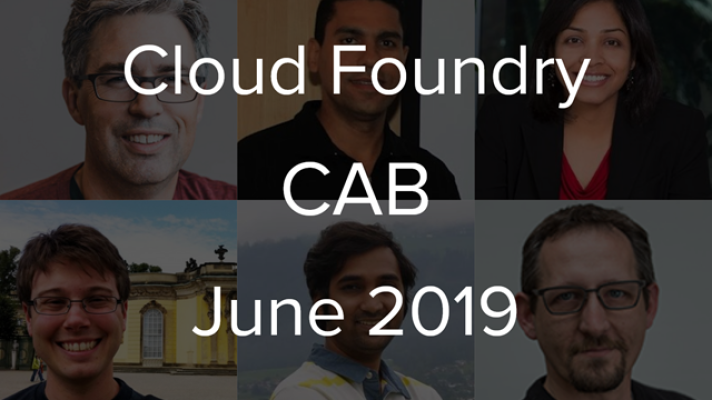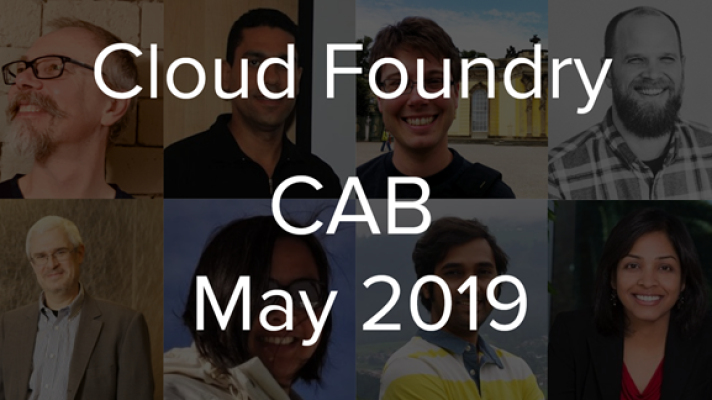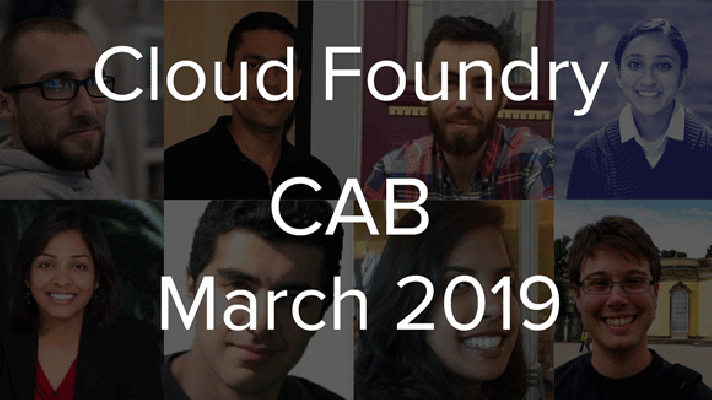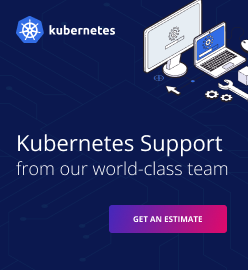Cloud Foundry Summit 2014: Day 2
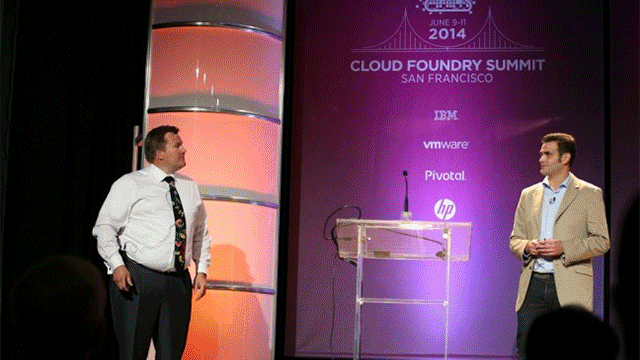
The second day of the conference began with keynotes from Pivotal, Parvus Captus, Monsanto, SAS, CoreLogic, SAP, HP, and IBM. After that, there were two tracks in parallel: business and technical. For those who didn’t attend, here is the summary of Day 2.
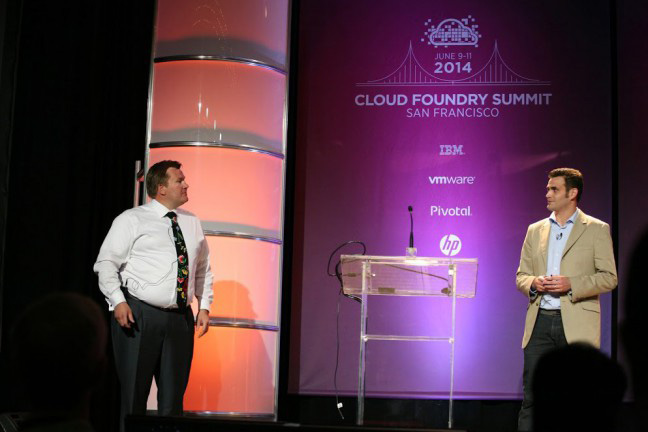
Announcements from HP, IBM, and Mendix
Some important pieces of news came up during day two:
HP announced that its new cloud strategy called HP Helion is all about OpenStack and Cloud Foundry. The Helion team is working to optimize the binding between the two systems.
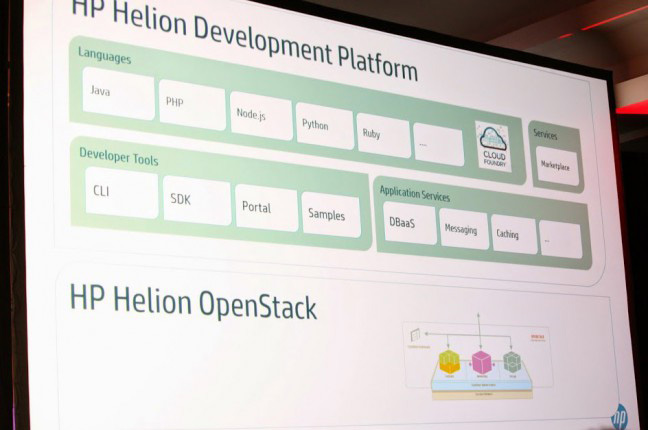
IBM revealed that DockerHub will be hosted on SoftLayer to provide better usability and simpler maintenance.
Mendix announced integration of its PaaS with Cloud Foundry. Support for Cloud Foundry also enables Mendix customers to work with third-party and private cloud stacks more easily and use Mendix on top of their Cloud Foundry implementations.
Keynotes
Many of the keynotes referenced OpenStack in some way.
James Watters, VP of Product, Marketing, and Ecosystem for Cloud Foundry @ Pivotal, began the summit with a great summary of the value provided by Cloud Foundry. He spoke about agility and analytics, the growth of Square, Uber, and Netflix, and how Cloud Foundry is going to change software development.
According to him, with the emergence of the third major disruptive platform—PaaS—that will be beyond mainframe and client/server. Traditional industries will be forced to change; the new approach will usher in a new generation of developers with different values. The development focus will shift from infrastructure to apps, there will be no planned downtime, etc. Finally, he mentioned that, currently, Cloud Foundry is the only multi-region PaaS without config changes, spurring a lot of tweets.
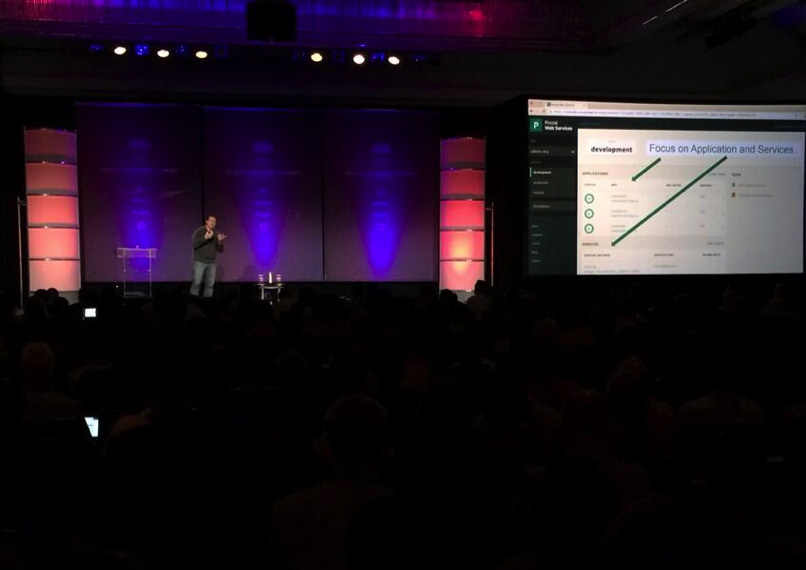
“With Pivotal CF, we didn’t just revolutionize the dev experience, we fundamentally changed the operator experience.” —James Watters, Pivotal
Mark Seidenstricker, Infrastructure Architect @ Monsanto, continued by presenting a solid business case on data-driven agriculture, saying that farming is deceptively technologically advanced and increasingly dependent on data and information. He described how disruptive innovation with PaaS helped the company to boost developer productivity by 50%.
At the beginning, Monsanto chose Cloud Foundry because it was a stable turn-key solution that provided application portability and developer agility with no vendor lock-in. They started with integrating the PaaS with JIRA. Today, Pivotal Cloud Foundry running on vSphere is the enabler of Monsanto’s cloud strategy, on track to help them double the agricultural yields by 2030. Mark also shared some advice on what should be the first step to adopting PaaS at an enterprise: you should start with a non-critical app proof of concept on a public cloud to assess the economics.
“Cloud Foundry puts the tools to solve a problem into the hands of the people who have the problem.” —Mark Seidenstricker, Monsanto
Casey Hadden, Software Developer and Architect @ SAS, told about the history of SAS that started with punch card processing. When adopting a PaaS system, their main requirements were: support for multiple IaaS, a user-friendly GUI, and availability of reporting apps. Cloud Foundry provided all that, as well as additional benefits, such as shared instances, transactions, containerization, etc. So the main drivers for adoption were scalability, availability, portability, and reliability of Cloud Foundry.
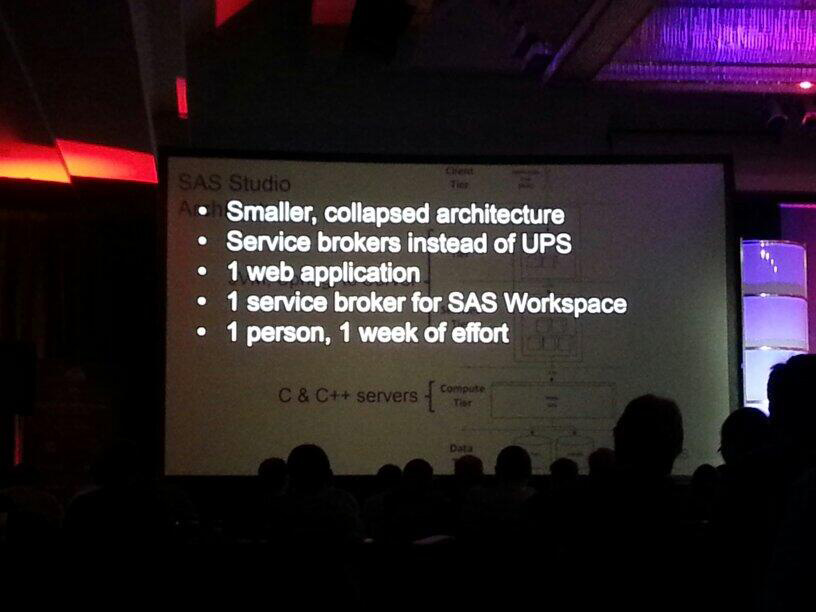
“Given the drivers, PaaS can be the enforcer. Cloud Foundry makes it a win for our developers.” —Casey Hadden, SAS
The keynote by Richard Leurig, Senior VP, Innovation Dev Center @ CoreLogic, presented another great use case of how a leading mortgage and real estate analytics company uses Cloud Foundry to take advantage of data, as if they were a Silicon Valley startup. With the “Everything-as-a-Service” approach of PaaS, CoreLogic has the flexibility to move applications between private and public clouds without re-writing the code. According to Richard, they “were given the opportunity to forget the legacy, but interoperate with the legacy.”
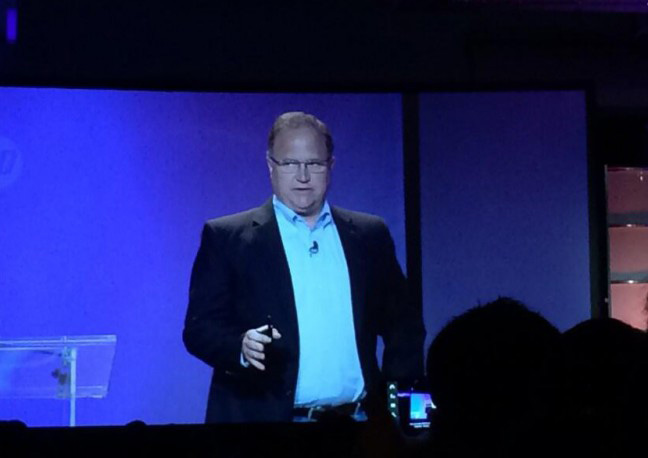
“We put our eggs in the Cloud Foundry basket.” —Richard Leurig, CoreLogic
The next keynote by Ben Hale, Java Experience Lead, Cloud Foundry @ Pivotal, was more technical than business-oriented. It reviewed the previous year for the Cloud Foundry Java buildpack, which is now apparently enterprise-ready. Ben emphasized that the buildpack strives to provide the safest possible environment for running apps. He also covered session replication with Redis and failover (buildpacks storing bits offline for compliance or air-gapped networks).
Steve Winkler, Open Cloud Strategy @ SAP, and Dirk Basenach, VP Development @ SAP, continued with their vision of the enterprise PaaS future. Currently, SAP is incorporating Cloud Foundry into the SAP HANA strategy. (It is currently being integrated as a Cloud Foundry service.) After building a solid Cloud Foundry platform for themselves, the company is planning to provide it to partners. Today, there are already some startups building projects on the HANA platform. In general, SAP believes that Cloud Foundry has a good chance of becoming the Linux of the cloud in some years.
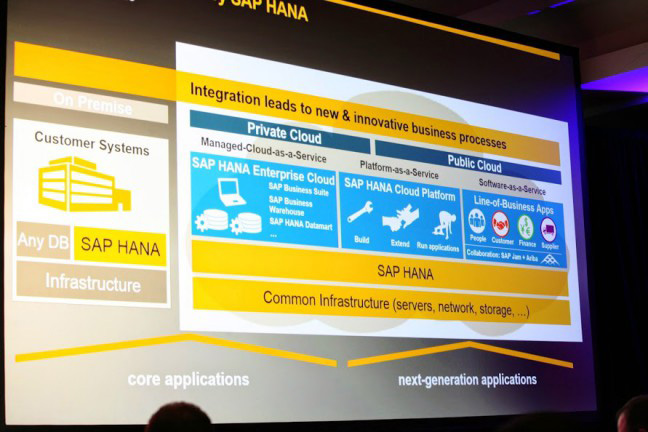
“The new bizapp world: you can approve an expense report from the pool. I did it yesterday” —Steve Winkler, SAP
The keynote by Manav Mishra, Director of Product, HP Helion, dispelled some of the fears related to adopting open platforms. According to HP, Cloud Foundry is a win-win solution because the value for the enterprise is in the app layer and developers absolutely love abstraction. In addition, since many of the components in Cloud Foundry and OpenStack are interoperable, Cloud Foundry could repeat OpenStack’s IaaS success at the PaaS level.
“We feel that Cloud Foundry and OpenStack are the platform of the future.” —Manav Mishra, HP
The final keynote by Angel Diaz, VP, IBM Standards and Cloud Labs and Bala Rajaraman, CTO Cloud Platform Services and Distinguished Engineer @ IBM, dwelled on BlueMix, IBM’s distro of Cloud Foundry. They also summarized the contributions of IBM to the ecosystem. Overall, IBM is trying to build a “platform for the people” that will be “open from top to bottom.”
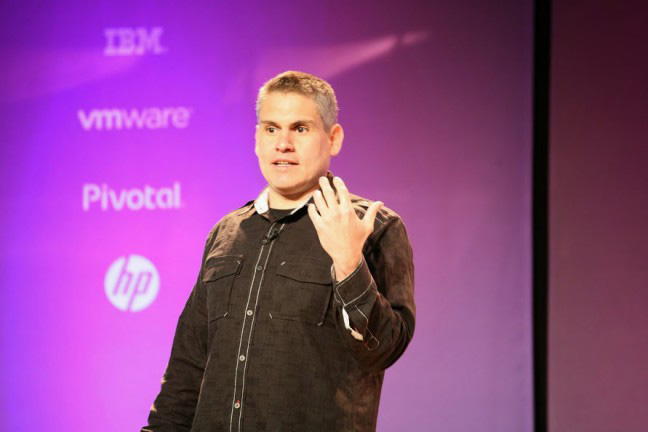
“Learn to Play, Know that Lag Kills, Avoid the Grind.” —Angel Diaz
Lightning talks
After a break, the summit continued with lightning talks.
Daniel Berg, IBM Distinguished Engineer and CTO for DevOps Tools and Strategy spoke about IBM Codename:BlueMix DevOps services.
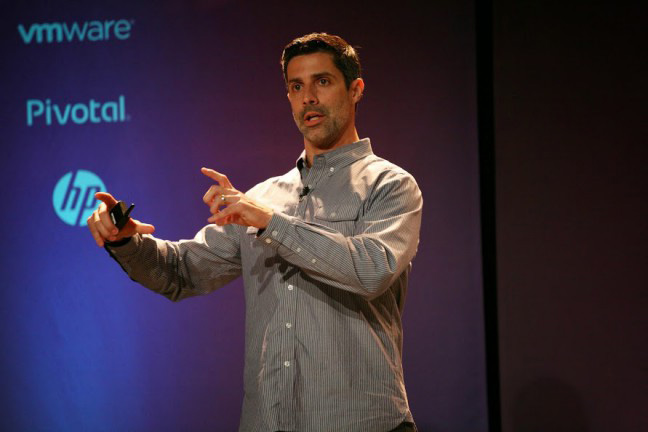
“Tools in the Cloud, for the Cloud.” —@dancberg
Dr. Wei-Min Lu, Founder and CEO @ Anchora, told the packed room about the Shanghai Jiao University PaaS, the first university community PaaS in China.
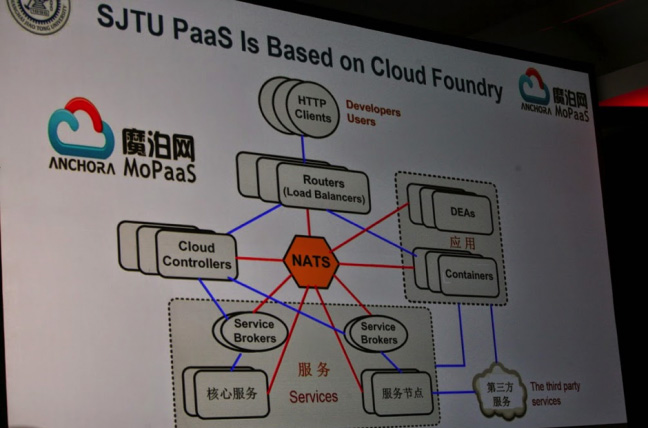
Mark Kropf, Runtime Product Manager, Cloud Foundry, shared how his team runs Cloud Foundry at scale at Pivotal Labs.
“Best Cloud Foundry feature request: ‘cf push’ and ‘cf push it real good’.” —@MarkKropf
Cornelia Davis, Platform Engineer, Cloud Foundry @ Pivotal spoke about the 4 layers of high availability built into Cloud Foundry to protect it from entropic failures that may happen in any cloud.
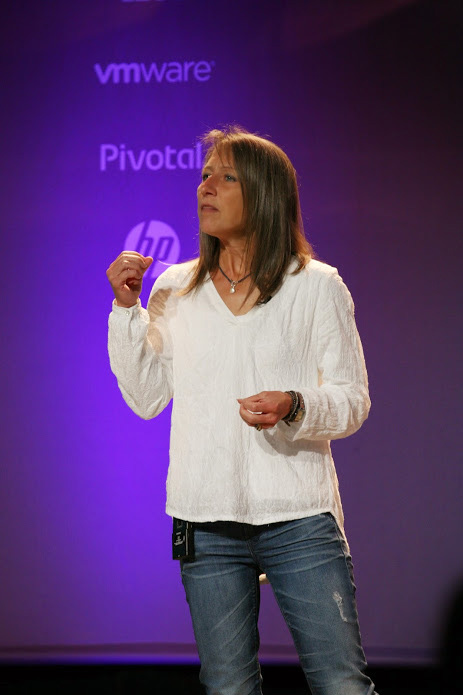
“The PaaS is just as important to the operator as it is to the developer.” —@cdavisafc
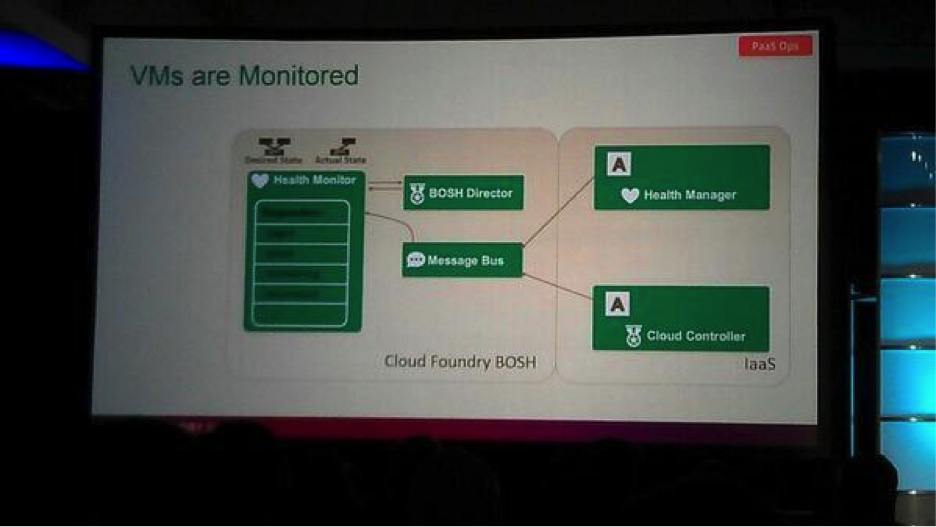
The final lightning talk by Mark Seidenstricker, Infrastructure Architect @ Monsanto, was about logging and monitoring, as well as about globalization and availability zones.
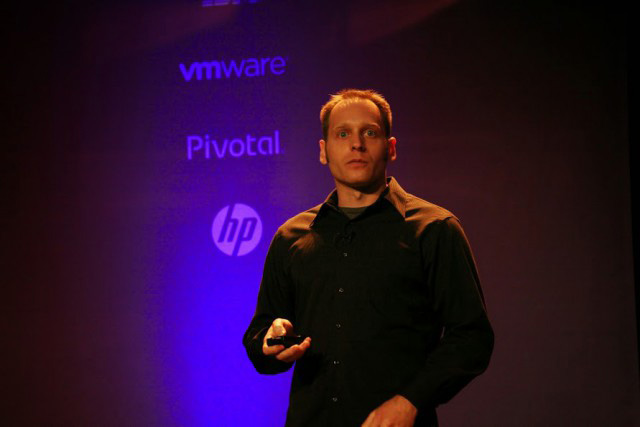
Conference sessions
Following the keynotes and lightning talks, the summit moved on to the sessions by Cloud Foundry contributors.
“The Journey From Print to Online-Driven Journalism Is Cloudy”—this session by Lajos Lange, Head of Online Development @ Axel Springer; Matthias Naber, Software Engineer @ Axel Springer; and Tore Sagstuen, CTO @ FjordIT, explained why Axel Springer chose Cloud Foundry over Heroku after a careful PaaS evaluation. FjordIT spoke about environmentally friendly “Green” PaaS powered by Cloud Foundry.
The business track
After that, the sessions were divided between two tracks: technical and business. Naturally, it was impossible to be at all of them at the same time, so I’m grateful to my colleagues of Altoros who shared their observations with me afterwards.
- “Hack for Good (and Profit)”
The business track session by Cornelia Davis of Pivotal and Catherine Spence, Principal Engineer and Architect at Intel, was dedicated to internal hackathons used by Intel to fuel interest to PaaS and Cloud Foundry. Hackathons encourage teamwork, give a possibility to build apps around a theme, and provide friendly competition that helps to innovate and build new things. So, it’s not just about the prizes.
“Bragging rights are crucial for participants in a hackathon.” —Cornelia Davis
“Cloud Foundry Compared With Other PaaSes”
The PaaS comparison by James Bayer, Director of Product Management @ Cloud Foundry, and Michael Maximilien, Chief Architect PaaS Innovation, IBM Cloud Labs, gave some fresh insights into how today’s major PaaS platforms compare against each other. The attendance was very high, people were taking photos of the slides all the time.
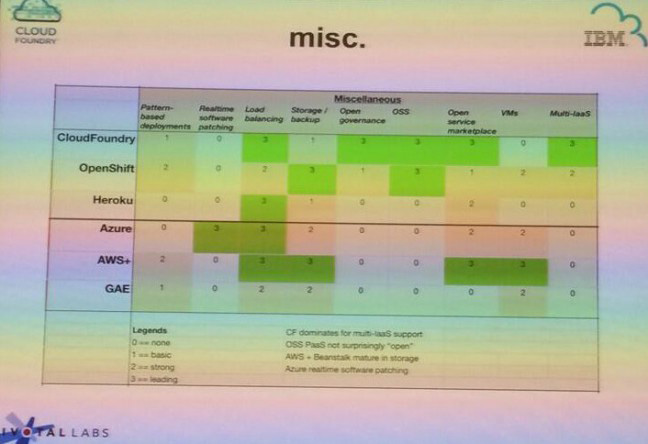
IBM started comparing PaaS systems—Google Compute Engine, Microsoft Azure, Heroku, OpenShift, and Cloud Foundry—back in 2010. What they demonstrated at the session was an evaluation covering 50 features. Although according to Michael Maximilien there is no benchmark for measuring PaaS features, Cloud Foundry is clearly a leader in data stores and management. In addition to that, while 60%-70% of all apps running on PaaS are Java-based, Java support in Cloud Foundry is best in class. The comparison did not include any data on cost, well, maybe we’ll be luckier next year.
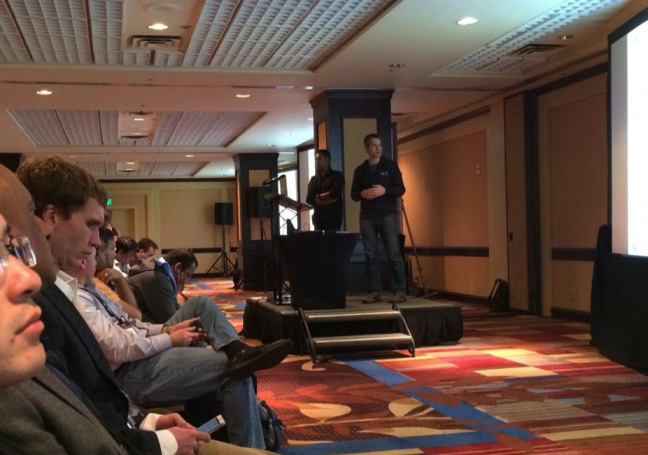
“Different PaaSes are highly incompatible.” —@jambay
For more details, read our recap of the session.
- “Future Data Platforms and PaaS Services”
Dave McCrory, CTO @ Basho, dived into PaaS database options and explained the difference between ready-made Cloud Foundry services and the oner made to order.
“All Things Jenkins and Cloud Foundry”
This business track session by Senior Director of Product Management at CloudBeeS, Harpreet Singh, was dedicated to Jenkins continuous integration on Cloud Foundry implemented by CloudBees. It overlapped with a session on Docker.
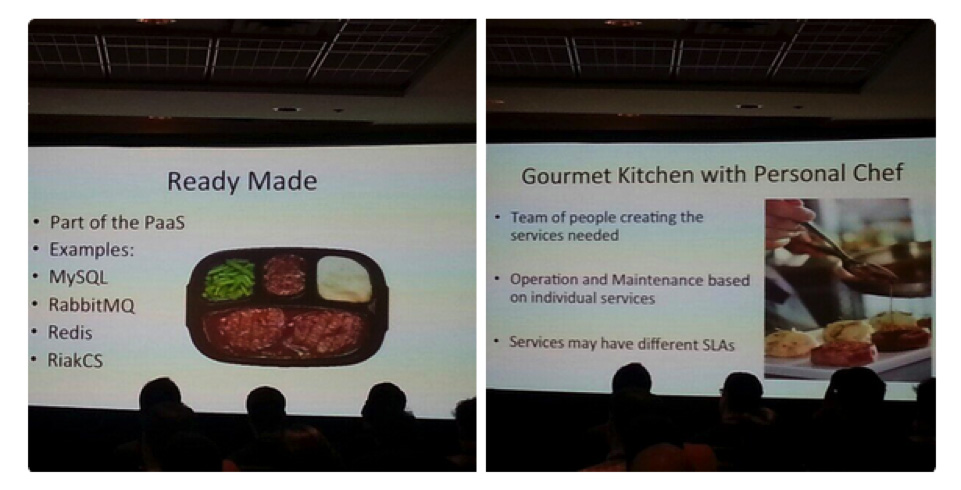
“One of the points of PaaS is to become more prescriptive and guide developers in the right direction.” —@mccrory
“Cloud Foundry and OpenStack—A Marriage Made in Heaven”
The business track session by Jason Anderson, Cloud Architect @ IBM; Egle Sigler, Principal Architect @ Rackspace; and Animesh Singh, Lead Architect and Strategist @ IBM was on the experience Rackspace and IBM had with running Cloud Foundry on OpenStack, including some best practices.
The technical track
“Autoscaling Distributed System with BOSH”
This was one of the most popular technical sessions: the room was absolutely packed. People were standing or even sitting on the floor while Yudai Iwasaki, Lead Engineer, Software Innovation Center @ NTT, explained how to start using the BOSH AutoScaler to automatically scale Cloud Foundry deployments. Great job!
- “Cloud Foundry Accelerates ‘DevOps+’”
The technical session by Yas Naoi of NTT Innovation Institute was dedicated to DevOps acceleration and gathered positive reviews. Unfortunately, it overlapped with the extremely popular PaaS comparison session.
- “OSv: Probably the Best OS for Cloud Workloads You’ve Never Heard of”
This was a great technical talk where Roman Shaposhnik, Sr. Manager, Hadoop @ Pivotal, compared VMs, Docker, and OSV, the new virtualization technology, as PaaS microservices.
“OSv is a unikernal for ‘POSIX’ and memory managed platforms (JVM, Go)” —@rhatr
“Cloud Foundry and Microservices: A Mutualistic Symbiotic Relationship”
In his technical session, Matt Stine, Platform Engineer, Cloud Foundry @ Pivotal, explained how the microservice-oriented architecture fits application deployment in Cloud Foundry. The talk covered such themes as operational overhead, failover, scale, health monitoring, load balancing, routing, monitoring, operations infrastructure, and buildpack support. The bottom line is that to use a Cloud Foundry microservice, you will need substantial DevOps skills and a good understanding of distributed system complexity.
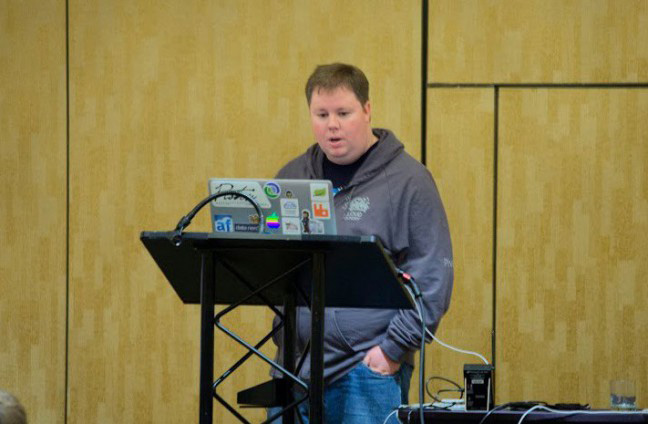
“Composable microservices embrace the classic Unix philosophy to do one thing and do it well.” —@mstine
“Managing Stateful Docker Containers with BOSH”
Ferran Rodenas, Staff Engineer, Cloud Foundry @ Pivotal, not only did a live demo of how to deploy Docker images with BOSH, but also created some on the fly in front of a full room—well, that was brave!
“Sending E-mails Reliably and Quickly From Your Cloud Foundry App With SendGrid”
Nick Quinlan, Developer Evangelist @ SendGrid, shared some insights on how to make sure your e-mails are delivered safely and on time using SendGrid on a PaaS.
“How to Build a High-performance Application Using Cloud Foundry and Redis”
As the name implies, this technical session by Yiftach Schoolman, CTO and Co-founder of Redis Labs, was dedicated to building high-load scalable Cloud Foundry apps using the Redis database.
The unconference and Cloud Foundry Hack Night
The second day ended with a birds-of-a-feather unconference and the hackathon, the Cloud Foundry Hack Night. Manuel Garcia, Director of Operations @ Altoros, made a live demo of autoscaling Cloud Foundry applications (check out the repo here).
Matthew Kocher of Pivotal demoed BOSH-lite. After voting, the participants got down to hacking CF while listening to the beats from a vertical deck of speakers provided by HP.
For those who craved some more technical knowledge, Pivotal also organized a meetup, “Java Application in the Cloud.”



